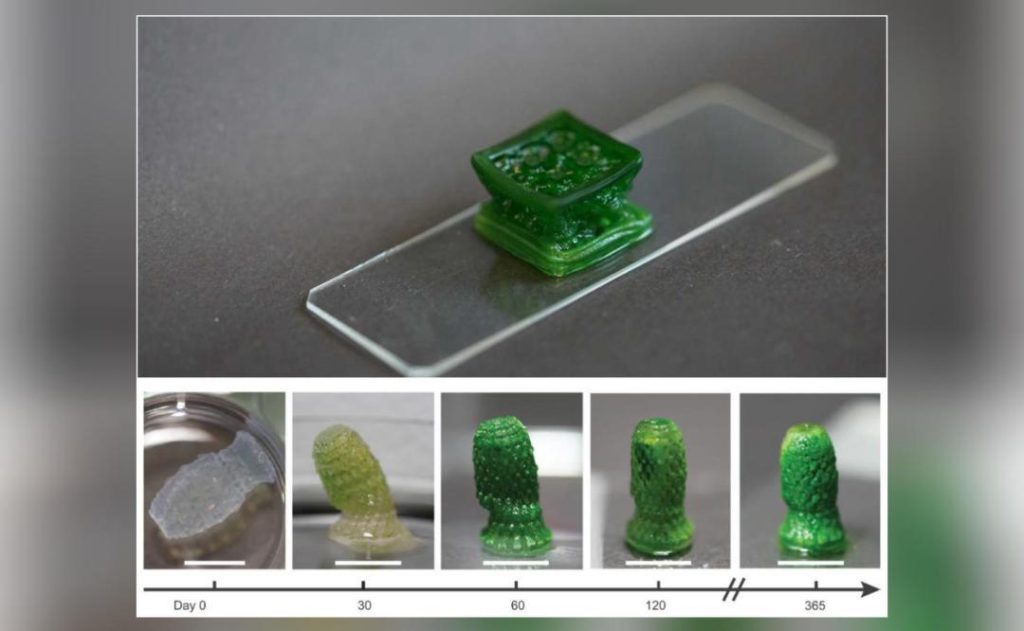
Pics show new ‘living’ material that absorbs CO2 from air
The quest to combat climate change has led to numerous innovations and breakthroughs in recent years. One of the most promising developments comes from Switzerland, where scientists have created a new “living” material that can absorb carbon dioxide (CO2) from the air through photosynthesis. This revolutionary material, containing blue-green algae (cyanobacteria), has the potential to make a significant impact in the fight against global warming.
According to a recent study, this living material can not only absorb CO2 but also convert it into solid carbonate minerals, such as limestone. This process can occur under specific conditions, making it an attractive solution for reducing carbon emissions.
The study, conducted by researchers at ETH Zurich, a Swiss Federal Institute of Technology, has sparked excitement among scientists and policymakers alike. The material, which is still in its early stages, has the potential to be used in buildings and other structures to absorb CO2 from the atmosphere.
How does it work?
The living material is comprised of blue-green algae, which are cyanobacteria that have been around for over 3.5 billion years. These microorganisms are capable of photosynthesis, a process that converts sunlight into energy. In this case, they use sunlight to absorb CO2 from the air and convert it into organic compounds.
The researchers have developed a way to encase the algae in a matrix made of a biocompatible polymer, creating a material that is both durable and sustainable. This matrix provides a suitable environment for the algae to thrive, allowing them to continue absorbing CO2 and converting it into carbonate minerals.
Converting CO2 into solid minerals
One of the most significant advantages of this living material is its ability to convert CO2 into solid minerals. This process, known as carbonation, occurs when the CO2 reacts with calcium ions to form calcium carbonate, a common mineral found in limestone.
This conversion process has several benefits. Firstly, it provides a way to store CO2 in a stable and long-term manner, reducing the amount of CO2 in the atmosphere. Secondly, the resulting carbonate minerals can be used as building materials, reducing the need for traditional materials that have a higher carbon footprint.
Potential applications
The possibilities for this living material are vast. In buildings, it could be used as a sustainable alternative to traditional materials, such as concrete and steel. By incorporating the material into walls, floors, and ceilings, it could absorb CO2 from the air, reducing the carbon footprint of the building.
In addition to buildings, the material could also be used in other applications, such as:
- Carbon capture and storage: The material could be used to capture CO2 from industrial sources and convert it into solid minerals, reducing emissions and storing carbon in a stable manner.
- Soil remediation: The material could be used to clean up contaminated soil by absorbing pollutants and converting them into harmless compounds.
- Biotechnology: The algae contained in the material could be used to produce biofuels, bioplastics, and other bioproducts.
Next steps
While the study has shown promising results, there is still much work to be done before this living material can be used on a large scale. The researchers are currently working to optimize the material’s performance, improve its durability, and reduce its production costs.
In addition, the material will need to undergo rigorous testing and evaluation to ensure its safety and effectiveness. This may involve testing its ability to withstand various environmental conditions, such as temperature, humidity, and exposure to pollutants.
Conclusion
The development of this living material is a significant breakthrough in the fight against climate change. By absorbing CO2 from the air and converting it into solid minerals, it has the potential to reduce carbon emissions and store carbon in a stable manner.
As researchers continue to refine the material and explore its potential applications, it is likely that we will see a significant impact on the built environment. From buildings to biotechnology, this living material has the potential to make a real difference in the quest to combat climate change.
Source:






